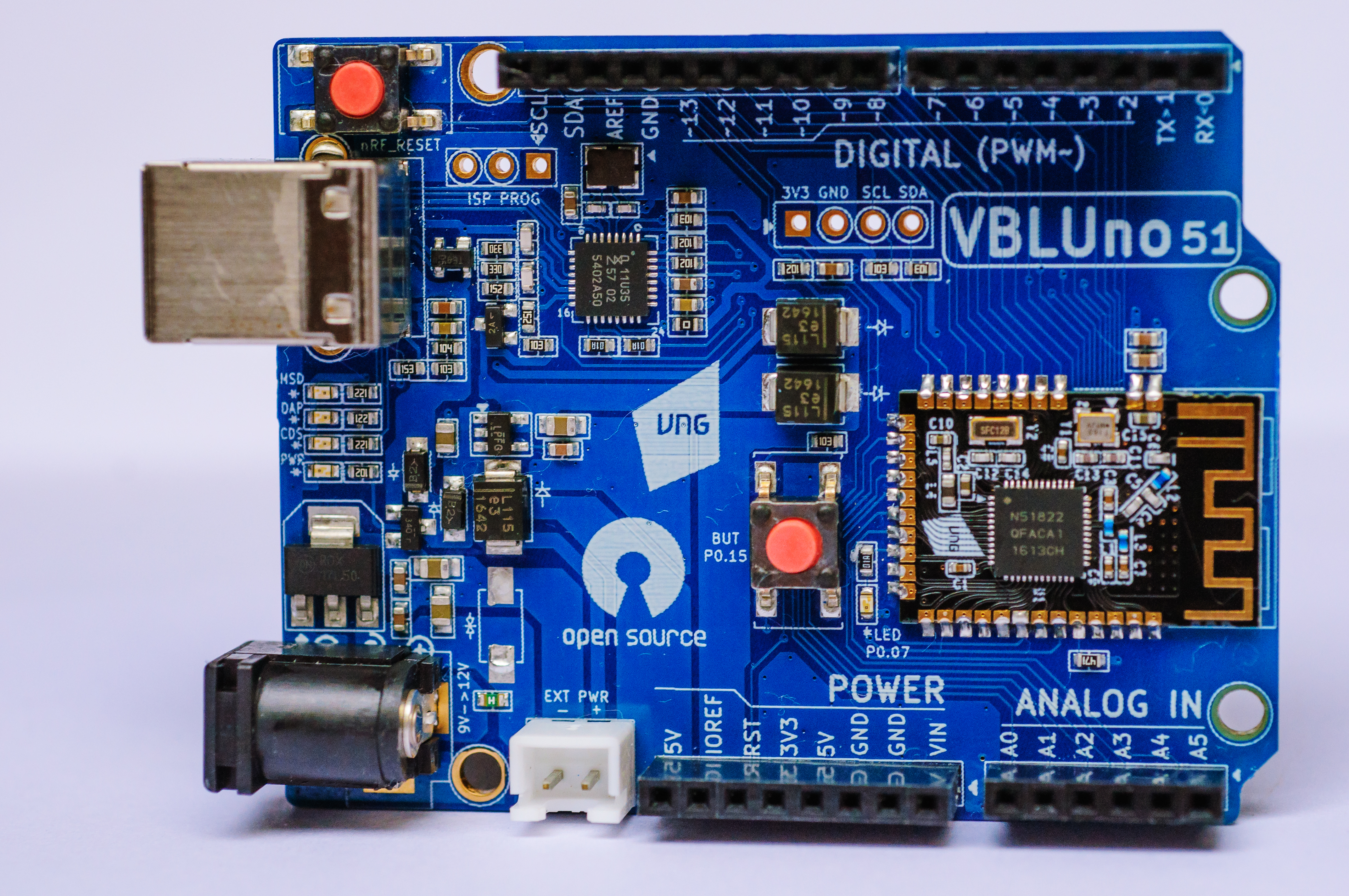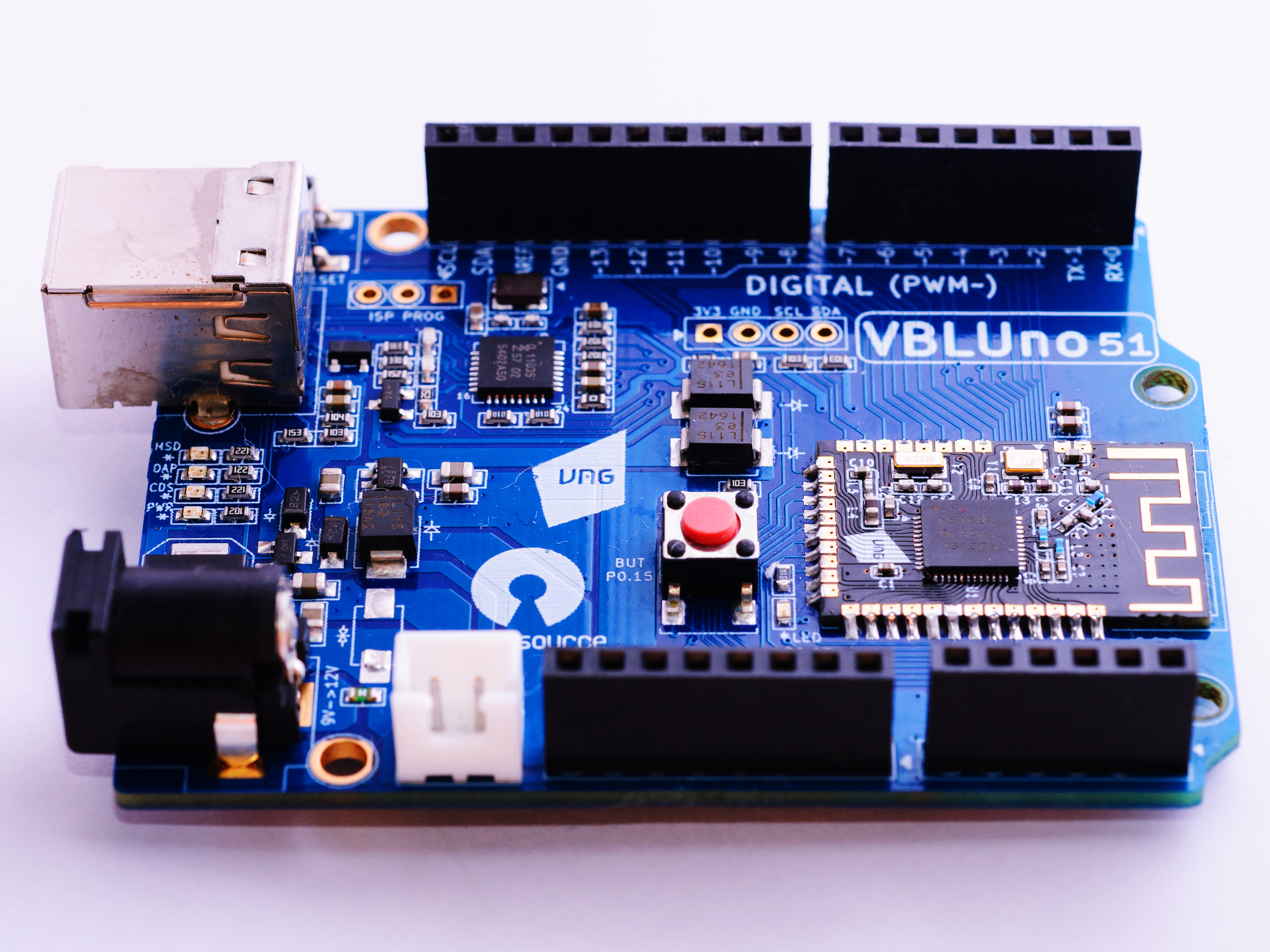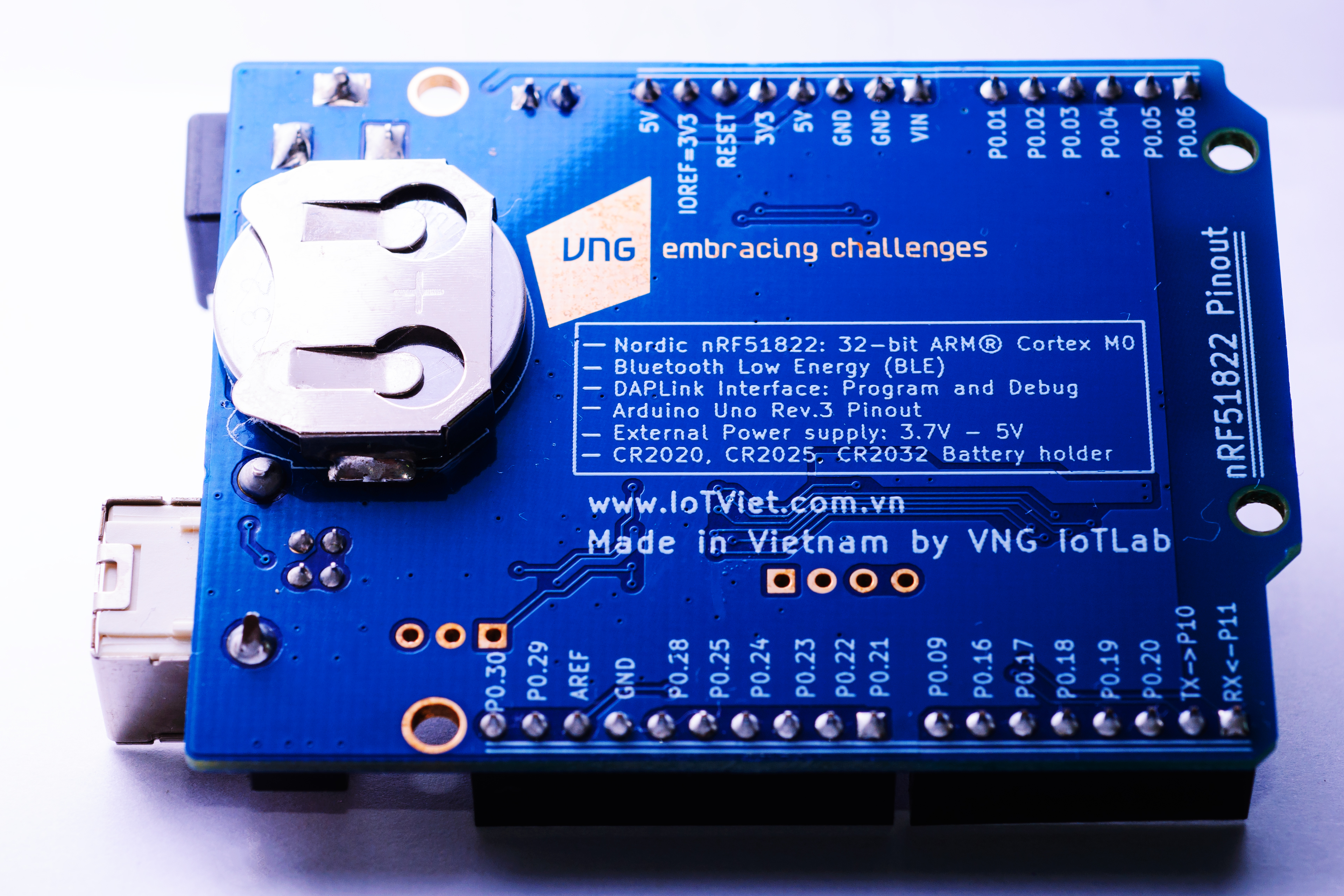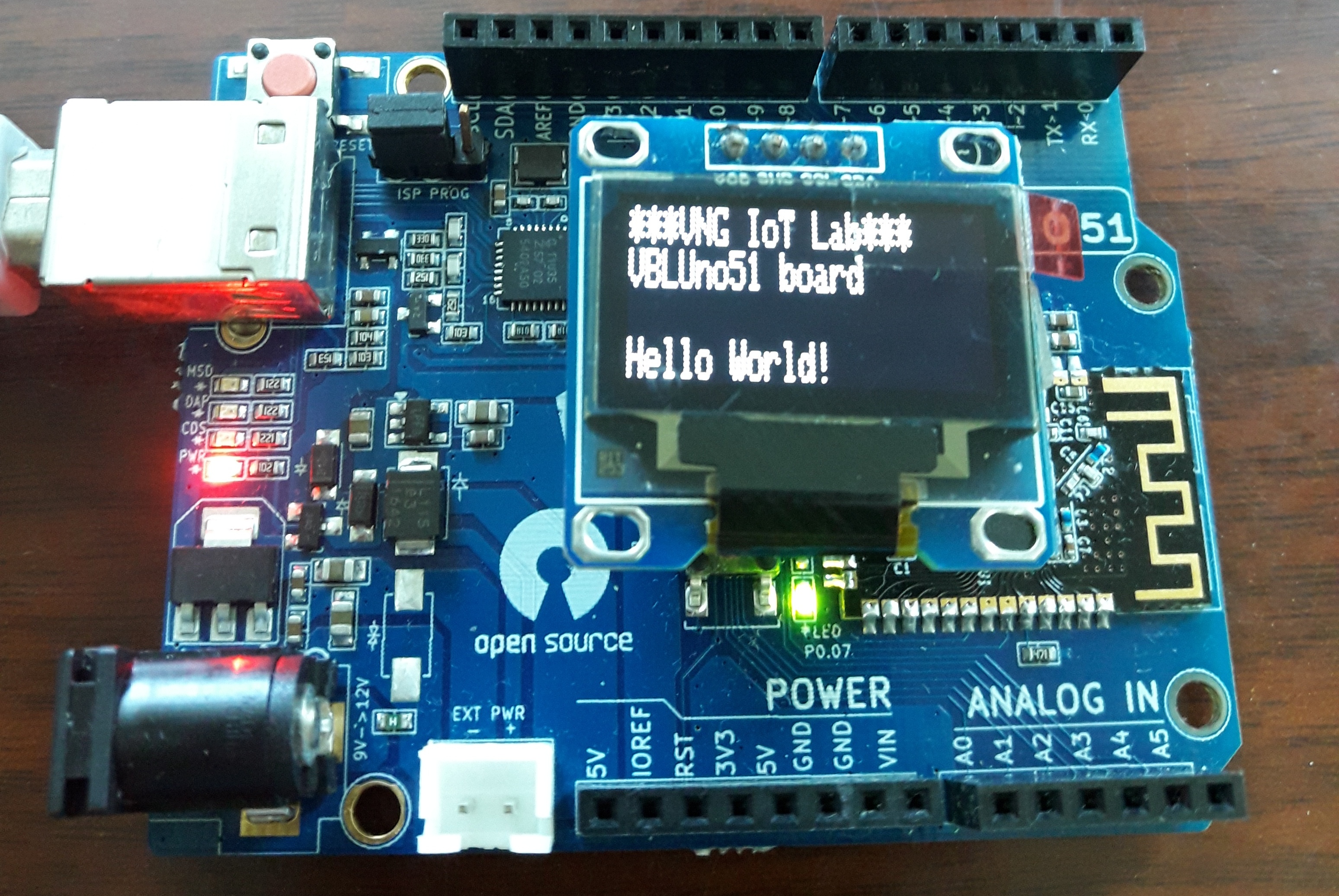Introduction
-
VBLUno51 board (VNG Bluetooth Low Energy UNO nRF51822) was created with the goal that VBLUno51 can help developers access easily Bluetooth Low Energy (BLE) technology and endless resources of Arduino, mbed-OS and other frameworks for developing applications for Internet of Things (IoT).
-
VBLUno51 is full compatibility with Nordic Software Development Kit (SDK) and many embedded operating systems which are suitable for IoT applications such as mbed-OS, Apache Mynewt-OS, RIOT-OS, Zephyr, …
-
The highlight of VBLUno51 board is BLE module was designed by VNGIoTLab engineers. This module has been used in many commercial products of VNG such as CSM Router, IoT Gateway, …. The BLE module uses the nRF51822 chip from Nordic Semiconductor, with 32-bit ARM Cortex-M0 core that supports Bluetooth Smart Interface (BLE) interfaces. Besides 6LoWPAN, Zigbee, …, BLE interfaces is considered as an extremely suitable communications for IoT, with near-distance communication applications and especially extremely low power consumption, environmentally friendly. Such as intelligent building systems, smart gardens, smart stores, children management, …
-
With the spirit of sharing and expecting the IoT community to access BLE technology more easy, VBLUno51 is published as an open source code, from hardware diagram, program source code example , source code bootloader, source code upload tool, documentation … You can reference and customize easily.
-
Through using VBLUno51 boards combined with Arduino IDE or mbed-OS, you can access easily build IoT applications with BLE technology, going to become owners of the terminal design in the IoT systems.
Actual image of the VBLUno51 board




Features
- CPU:
- Nordic nRF51822: ARM® Cortex™ M0 32bit.
- Bluetooth Low Energy interface.
- 256KB Flash, 32KB Ram.
- UART(1), I2C(2), SPI(1), PWM(3), SWD, Timer 16bit(3).
- 21 digital channels, 6 ADC 10bit channels.
- 1 Led and 1 Button onboard.
- GPIO Voltage: 0 – 3.3V.
- DAPLink (CMSIS-DAP) interface for program and debug:
- USB MSD: Drag and Drop programming flash memory.
- USB HID (DAP): CMSIS-DAP compilant debug channel.
- USB CDC: Virtual COM port for log, trace and terminal emulation. Supports hardware flow control features (RTS/CTS).
- Energy monitoring for BLE module by current measurement (Only VBLUno51_EM)
- FOTA (Firmware over the air): Upgrade firmware over BLE interface.
- Build good applications with:
- Compiler and IDE: GCC, Keil MDK, IAR, Eclipse, Qt Creator.
- Frameworks: Arduino, ARM mbed-OS, Nordic SDK, RIOT-OS, Apache MyNewt-OS,…
- A lot of tutorials for Arduino, mbed-os and more.
- Pinout: Arduino Uno Rev3 compilant.
- Power:
- USB port.
- Power adapter: +9 -> +12V.
- 3V Battery: CR20xx holder
- Recharageable battery jump: +3.7 -> +12V
- Open source: Hardware design, firmware, packages, tutorial and example codes
Details
| Ord | Feature | Description |
|---|---|---|
| 1 | CPU | Nordic nRF51822, ARM Cortex-M0 32-bit core |
| 2 | 2.4GHz wireless communication | Support Bluetooth Low Energy interface (Bluetooth Smart) |
| +4dBm to -20dBm output power in 4dBm steps | ||
| -30dBm output power in whisper mode | ||
| -96dBm RX sensitivity at 250kbs | ||
| -90dBm RX sensitivity at 1Mbps | ||
| -85dBm RX sensitivity at 2Mbps | ||
| 2 Mbps, 1 Mbps and 250kbs supported data rates | ||
| Excellent co-existence performance | ||
| 3 | System clock | 16MHz |
| 4 | Ultra low power consumption | |
| 6.3mA - TX at -4dBm (3V using on-chip DC-DC) | ||
| 8.0mA - TX at 0dBm (3V using on-chip DC-DC) | ||
| 11.8mA – TX at +4dBm (3V using on-chip DC-DC) | ||
| 9.7mA – RX (3V using on-chip DC-DC) | ||
| 13mA – RX at 1Mbps (No DC-DC) | ||
| 10.5mA – TX at 0dBm (No DC-DC) | ||
| 0.6µA – SYSTEM-OFF, no RAM retention | ||
| 1.2µA - SYSTEM-OFF, 8KB RAM retention | ||
| 2.6µA - SYSTEM-ON, All peripherals in idle mode | ||
| 5 | Digital I/O | 21 channel; GPIO Voltage: +3.6V |
| 6 | ADC | 6 channel; Resolution: 10bit; Voltage range: 0 ÷ +3.3V |
| 7 | Timer | 16bit x 3 with Counter mode |
| 8 | UART | 01 |
| 9 | SPI | 01 |
| 10 | I2C | 02 |
| 11 | PWM | Every GPIO channel (Max 3 channel at the same time); |
| 8bit, 16bit mode; | ||
| 12 | External interrupt | On every GPIO channel. |
| 13 | Flash program | Drag and Drop programming flash memory. (Support auto programming when use Upload function on Arduino IDE. |
| 14 | Debug | CMSIS-DAP compilant debug channel. It work fine on Keil uVision, pyOCD, OpenOCD,… |
| 15 | Virtual COM port | USB to UART |
| It work fine at 2400 to 115200 speed and more. | ||
| Support Hardware flow control (RTS/CTS). | ||
Support Send Break command. |
||
| 16 | Power supply | +3.7V -> +12V. (USB port, Power adapter, CR20xx battery, rechargeable battery). |
| 17 | Pinout | Arduino Uno Rev3 compatible |